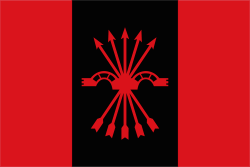Sección Femenina
| Part of a series on |
| Falangism |
|---|
 |
|
Literature
|
|
Related topics |
| Politics portal |
Sección Femenina (Women's Section) was the women's branch of the Falange political movement in Spain. Founded in 1934, it subsequently became an official institution in the Francoist era. Following General Franco's death and the beginning of the transition to democracy it was disbanded on 1 April 1977 together with all Movimiento Nacional institutions.[1] Sección Femenina was led throughout its history by Pilar Primo de Rivera, the younger sister of Falange founder José Antonio Primo de Rivera.
Sección Femenina was conceived from the beginning as an extension of the domestic role of women to the public sphere, though it took part in political activities during the 1936 election's campaign.[2] During the Second Republic the members of Sección Femenina supported the male Falangists in tasks such as paying visits to imprisoned members and their families. Following the breakout of the Civil War in 1936 they supported the families of those killed in the National faction and took care of the basic assistance to the population of conquered cities. In 1937 Sección Femenina became an official institution as Franco entrusted it the organization of Servicio Social de la Mujer (Social Service for Women), a compulsory female equivalent of the Francoist military service centered in housework.[3] The Castle of La Mota in Medina del Campo, Valladolid served as its headquarters from 1942.[4]
Initially Sección Femenina was organised in three delegaciones: Movimiento femenino (led by Pilar Primo de Rivera), Auxilio Social (led by Mercedes Sanz Bachiller, the widow of Onésimo Redondo) and Frentes y Hospitales (led by María Rosa Urraca Pastor). The three leaders did not work together well. Following constant clashes with Primo de Rivera Urraca resigned in 1938 and Sanz was marginalized after the Civil War.[5]
Pilar Primo de Rivera summed up the organization's mission as a silent, constant labor that will bring us no compensation but thinking how thanks to Falange's work women will be cleaner, children will be healthier and houses will be tidier.[6] Sección Femenina's main role was instructing Spanish women in Francoist patriotic, religious and social morals. Women were taught they were inferior to men and should remain subordinated to them, with marriage, children and housework being their main goals in life. They were discouraged from developing their creative talent, which Primo de Rivera denied: Women never discover anything. They lack creative talent, reserved by God for virile intellects. We can do no more than interpret what men present to us.[7] Isabella I of Castile and Saint Teresa of Ávila served as Sección Femenina's inspirational models.[8]
Sección Femenina also organized women's sports and promoted musical folklore.[9] In 1963 it founded the Medina (in allusion to Medina del Campo) and CREFF (Colegios Reunidos de Educación Física Femenina) sports societies and created the first regular national women's leagues in Spain for sports such as basketball, handball and volleyball. While the leagues were not restricted to Medina and CREFF teams, they were mostly comprised by them; for instance, by 1973 the handball league was contested by the Medina sections in Castellón, La Coruña, Guipúzcoa, Málaga, Santander, Valencia (which would later become European champion BM Sagunto) and Zaragoza plus Atlético Madrid.[10] However, by then the sports societies had become a severe financial strain for Sección Femenina and in 1974 the teams were told to find a sponsor. Most of them folded subsequently.[11]
References
- ↑ Profile of Sección Femenina in Palencia's Provincial Historical Archive's website
- ↑ Synopsis of the article From the creation of Sección Femenina to the 1936 electoral campaign: modalities of intervention of Falangist women in the public sphere by Christine Lavail in the University of Granada's magazine Revista Arenal, Vol. 15 No. 2
- ↑ Do you remember? The women's mili. Radiotelevisión Española
- ↑ His Excelence the Head of State made donation of the Castle of La Mota to Selección Femenina de Falange as school of their mandos and pronounced in the trascendental ceremony a speech of utmost importance. ABC, 30 May 1942
- ↑ http://salamancamemoriayjusticia.org/bib/Delgado%20Bueno%20Seccion%20Femenina.pdf
- ↑ Carmen Domingo, Con voz y voto, page 322. Lumen, 2004
- ↑ Arthur G. Payne, Fascism in Spain, 1923-1977, page 324. University of Wisconsin Press
- ↑ A historian accounts the political use of Isabel la Católica and Santa Teresa. El Mundo
- ↑ Profile of the Sección Femenina Folklore Archive in Biblioteca Nacional de España's website
- ↑ Teucro and Barcelona contest today the final of the league's First Division. El Mundo Deportivo
- ↑ Concepción Carbajosa, Involvement of Asturian women in sports, 1939-1977, page 325. University of Oviedo Publishing Service